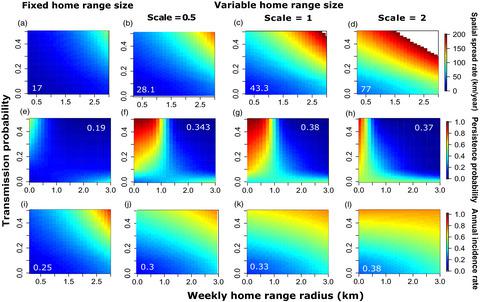当前位置:
X-MOL 学术
›
J. Anim. Ecol.
›
论文详情
Our official English website, www.x-mol.net, welcomes your feedback! (Note: you will need to create a separate account there.)
Variation in host home range size decreases rabies vaccination effectiveness by increasing the spatial spread of rabies virus
Journal of Animal Ecology ( IF 4.8 ) Pub Date : 2020-02-15 , DOI: 10.1111/1365-2656.13176 Katherine M McClure 1, 2 , Amy T Gilbert 1 , Richard B Chipman 3 , Erin E Rees 4, 5 , Kim M Pepin 1
Journal of Animal Ecology ( IF 4.8 ) Pub Date : 2020-02-15 , DOI: 10.1111/1365-2656.13176 Katherine M McClure 1, 2 , Amy T Gilbert 1 , Richard B Chipman 3 , Erin E Rees 4, 5 , Kim M Pepin 1
Affiliation

|
Abstract Animal movement influences the spatial spread of directly transmitted wildlife disease through host–host contact structure. Wildlife disease hosts vary in home range‐associated foraging and social behaviours, which may increase the spread and intensity of disease outbreaks. The consequences of variation in host home range movement and space use on wildlife disease dynamics are poorly understood, but could help to predict disease spread and determine more effective disease management strategies. We developed a spatially explicit individual‐based model to examine the effect of spatiotemporal variation in host home range size on the spatial spread rate, persistence and incidence of rabies virus (RABV) in raccoons (Procyon lotor). We tested the hypothesis that variation in home range size increases RABV spread and decreases vaccination effectiveness in host populations following pathogen invasion into a vaccination zone. We simulated raccoon demography and RABV dynamics across a range of magnitudes and variances in weekly home range size for raccoons. We examined how variable home range size influenced the relative effectiveness of three components of oral rabies vaccination (ORV) programmes targeting raccoons—timing and frequency of bait delivery, width of the ORV zone and proportion of hosts immunized. Variability in weekly home range size increased RABV spread rates by 1.2‐fold to 5.2‐fold compared to simulations that assumed a fixed home range size. More variable host home range sizes decreased relative vaccination effectiveness by 71% compared to less variable host home range sizes under conventional vaccination conditions. We found that vaccination timing was more influential for vaccination effectiveness than vaccination frequency or vaccination zone width. Our results suggest that variation in wildlife home range movement behaviour increases the spatial spread and incidence of RABV. Our vaccination results underscore the importance of prioritizing individual‐level space use and movement data collection to understand wildlife disease dynamics and plan their effective control and elimination.
中文翻译:

宿主范围大小的变化会增加狂犬病病毒的空间传播,从而降低狂犬病疫苗接种的有效性
摘要 动物运动通过宿主-宿主接触结构影响直接传播的野生动物疾病的空间传播。野生动物疾病宿主的家庭相关觅食和社会行为各不相同,这可能会增加疾病爆发的传播和强度。人们对宿主活动范围变化和空间利用对野生动物疾病动态的影响知之甚少,但可能有助于预测疾病传播并确定更有效的疾病管理策略。我们开发了一个基于个体的空间明确模型,以研究宿主栖息地大小的时空变化对浣熊(Procyon Lotor)中狂犬病病毒(RABV)的空间传播率、持久性和发病率的影响。我们测试了这样的假设:在病原体侵入疫苗接种区后,家庭范围大小的变化会增加 RABV 的传播并降低宿主群体的疫苗接种有效性。我们模拟了浣熊的人口统计和 RABV 动态,涵盖了浣熊每周活动范围大小的一系列幅度和变化。我们研究了不同的活动范围大小如何影响针对浣熊的口服狂犬病疫苗接种 (ORV) 计划的三个组成部分的相对有效性——诱饵投放的时间和频率、ORV 区域的宽度以及免疫宿主的比例。与假设固定活动范围大小的模拟相比,每周活动范围大小的变化使 RABV 传播率增加了 1.2 倍至 5.2 倍。在传统疫苗接种条件下,与宿主范围大小变化较小的宿主相比,宿主范围大小变化较大的相对疫苗接种有效性降低了 71%。我们发现,疫苗接种时间比疫苗接种频率或疫苗接种区宽度对疫苗接种效果的影响更大。我们的研究结果表明,野生动物活动范围内运动行为的变化增加了狂犬病病毒的空间传播和发病率。我们的疫苗接种结果强调了优先考虑个人层面的空间使用和运动数据收集的重要性,以了解野生动物疾病动态并规划其有效控制和消除。
更新日期:2020-02-15
中文翻译:

宿主范围大小的变化会增加狂犬病病毒的空间传播,从而降低狂犬病疫苗接种的有效性
摘要 动物运动通过宿主-宿主接触结构影响直接传播的野生动物疾病的空间传播。野生动物疾病宿主的家庭相关觅食和社会行为各不相同,这可能会增加疾病爆发的传播和强度。人们对宿主活动范围变化和空间利用对野生动物疾病动态的影响知之甚少,但可能有助于预测疾病传播并确定更有效的疾病管理策略。我们开发了一个基于个体的空间明确模型,以研究宿主栖息地大小的时空变化对浣熊(Procyon Lotor)中狂犬病病毒(RABV)的空间传播率、持久性和发病率的影响。我们测试了这样的假设:在病原体侵入疫苗接种区后,家庭范围大小的变化会增加 RABV 的传播并降低宿主群体的疫苗接种有效性。我们模拟了浣熊的人口统计和 RABV 动态,涵盖了浣熊每周活动范围大小的一系列幅度和变化。我们研究了不同的活动范围大小如何影响针对浣熊的口服狂犬病疫苗接种 (ORV) 计划的三个组成部分的相对有效性——诱饵投放的时间和频率、ORV 区域的宽度以及免疫宿主的比例。与假设固定活动范围大小的模拟相比,每周活动范围大小的变化使 RABV 传播率增加了 1.2 倍至 5.2 倍。在传统疫苗接种条件下,与宿主范围大小变化较小的宿主相比,宿主范围大小变化较大的相对疫苗接种有效性降低了 71%。我们发现,疫苗接种时间比疫苗接种频率或疫苗接种区宽度对疫苗接种效果的影响更大。我们的研究结果表明,野生动物活动范围内运动行为的变化增加了狂犬病病毒的空间传播和发病率。我们的疫苗接种结果强调了优先考虑个人层面的空间使用和运动数据收集的重要性,以了解野生动物疾病动态并规划其有效控制和消除。



























 京公网安备 11010802027423号
京公网安备 11010802027423号